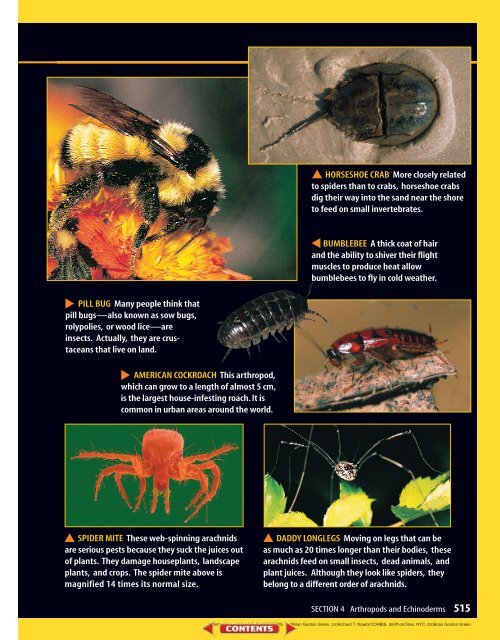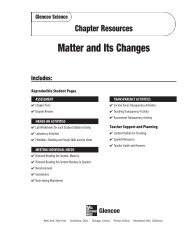Chapter 17: Invertebrate Animals
Chapter 17: Invertebrate Animals
Chapter 17: Invertebrate Animals
You also want an ePaper? Increase the reach of your titles
YUMPU automatically turns print PDFs into web optimized ePapers that Google loves.
▼<br />
HORSESHOE CRAB More closely related<br />
to spiders than to crabs, horseshoe crabs<br />
dig their way into the sand near the shore<br />
to feed on small invertebrates.<br />
▼<br />
BUMBLEBEE A thick coat of hair<br />
and the ability to shiver their flight<br />
muscles to produce heat allow<br />
bumblebees to fly in cold weather.<br />
PILL BUG Many people think that<br />
pill bugs—also known as sow bugs,<br />
rolypolies, or wood lice—are<br />
insects. Actually, they are crustaceans<br />
that live on land.<br />
▼<br />
AMERICAN COCKROACH This arthropod,<br />
which can grow to a length of almost 5 cm,<br />
is the largest house-infesting roach. It is<br />
common in urban areas around the world.<br />
▼<br />
SPIDER MITE These web-spinning arachnids<br />
are serious pests because they suck the juices out<br />
of plants. They damage houseplants, landscape<br />
plants, and crops. The spider mite above is<br />
magnified 14 times its normal size.<br />
▼<br />
DADDY LONGLEGS Moving on legs that can be<br />
as much as 20 times longer than their bodies, these<br />
arachnids feed on small insects, dead animals, and<br />
plant juices. Although they look like spiders, they<br />
belong to a different order of arachnids.<br />
▼<br />
SECTION 4 Arthropods and Echinoderms 515<br />
(tl)John Shaw, (tr)Scott T. Smith/CORBIS , (cl)Brian Gordon Green, (cr)Richard T. Nowitz/CORBIS, (bl)PhotoTake, NYC, (br)Brian Gordon Green














